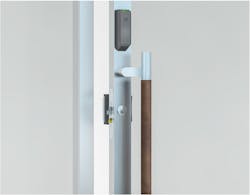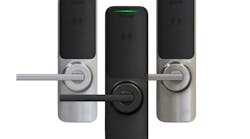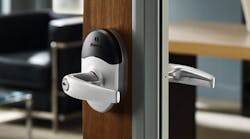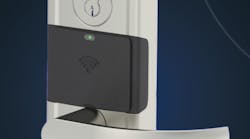When it comes to electrifying aluminum storefront doors as part of a retrofit, locksmiths basically have a choice: the Adams Rite Steel Hawk 4300 deadlatch and everything else.
Because of the 4300’s features and the sheer number of narrow-stile aluminum doors in the market that have the Adams Rite MS prep (said to be in the millions), the choice largely has been a no-brainer, which is why the 4300 has a position of dominance in the market with respect to electrification.
Security pros are about to get another option, one that could be as much of a game-changer as the 4300 was. Put it this way: What if you had the 4300’s deadlatch design and features, as well as its MS-prep retrofit capability, but its installation and operation were wireless?
That’s essentially what the Adams Rite DL100 Wireless Deadlatch will bring to bear. Locksmith Ledger got an advanced view of the latest product in ASSA ABLOY’s wireless Aperio lineup before its expected launch, and we’re eager to see it in the field. So are others.
“Wiring a storefront door is a pain,” says Larry Schwalb, security engineer with Houdini Lock & Safe of Philadelphia. He mentions the necessity to run wires through the door in the ceiling or basement, if possible, and dealing with a big pane of glass in the door. “Locksmiths have generally wanted to just work in the lock area. They really don’t want to go further, so that’s why all this wireless technology is enticing.”
The DL100 combines a deadlatch that’s based off the 4300 and a Securitron R100 reader. The reader is powered by two AA lithium batteries and connects with the deadlatch via a couple of wires. It can connect wirelessly to an electronic access control system through an Aperio hub.
Technically, the DL100 will replace the A100 in ASSA ABLOY’s Aperio lineup, but a big difference between the two products is that the DL100 is a wireless deadlatch, whereas the A100 is a wireless trim for deadlatches, deadlocks and exit devices. As such, the DL100 can replace existing mechanical Adams Rite 4500 and 4900 series deadlatches and 1850 Series deadlocks but won’t work with exit devices, says Sylvons Iyavoo, the senior product manager for Adams Rite.
(A wireless trim that could work with exit devices is in “the infancy stage” of development, Iyavoo says.)
Wired Vs. Wireless
The DL100 borrows from the 4300 design, particularly with respect to the 4300’s dual two-way winged latchbolts (main and auxiliary), which are known for their capability to repel loiding attacks. However, Iyavoo cautions that the DL100 is meant to be a complement to the 4300, not a replacement.
“We have two different markets for these two products,” he says. “There can be a certain percentage of cannibalization [of sales], but I wouldn’t say that’s going to be substantial.”
Iyavoo acknowledges that a wireless product generally is preferable from an installation standpoint, but many customers prefer wired locks over wireless for several reasons. One big reason is that a wireless lock, such as the DL100, has to have battery power, and batteries have to be replaced from time to time.
(Adams Rite says a customer should get two years of service under normal conditions before having to replace the batteries, and replacing the batteries is as simple as removing a screw on the reader and then the reader cover.)
“Some customers do not like it,” Iyavoo says of the necessity of changing batteries. “They say, ‘I want to install it and forget it.’” A wired lock is powered by the building’s electrical grid, and power is always available. He adds that some prefer the reliability of a wired electronic lock, although reliability isn’t as much of an issue in reality as it is in perception.
Also, there might be a preference for one of the features that’s in the 4300 but not the DL100 — a solenoid. The 4300 has a solenoid to drive the latching and unlatching process; the DL100 has a low-power motor, which is necessary so it can run on batteries, Iyavoo says.
A solenoid allows for instant retraction and access, which can be important in a high-traffic area. In such a scenario, a motor’s slight delay might cause preload on the lock, which can lead to reduced performance. Further, a solenoid’s louder activation might be preferred under certain conditions.
Battery Issues
Schwalb mentions another drawback for battery power — extreme temperatures. Simply put, batteries tend to have problems in extreme heat or cold. The DL100 has been certified to operate at temperatures between 14 degrees Fahrenheit and 140 degrees F. The high temperature isn’t much of a concern in North America, but the low one definitely is, particularly the farther north one goes.
“This is a great solution as long as the ambient temperature outside is above 14 degrees,” Schwalb says. “That’s something the specifier needs to be on the lookout for.”
Iyavoo says this wouldn’t affect 80 percent of the country, but he acknowledges that operation in cold temperatures is a problem. The issue was the same for the HES ES100 wireless strike that was introduced in spring 2021, with one important difference: The ES100 was expected to be used primarily indoors. The DL100, aimed at aluminum storefront doors, was expected to be used primarily outdoors.
The solution: a cold-weather kit that includes a heating element that would be installed inside the reader. This would come as a separate option that could be specified along with the DL100 for areas where cold weather would be an issue.
The kit will be available in two options: battery power or hard-wired. Iyavoo says hard-wiring the heating element of the DL100 is nothing like hard-wiring a standard deadlatch. Installing the 4300 Steel Hawk, for example, would require wiring the deadlatch and reader as well as connecting the reader with an EAC system.
“We’re eliminating all that,” Iyavoo says. For the DL100 and the hard-wired heating element, all that’s necessary would be wiring power to the heating element in the reader. Data communication would remain wireless.
Also, the cost difference is substantial. “If you buy a 4300, for example, you need to buy a separate reader,” Iyavoo notes. “To buy a reader and lock separately and have an access control guy come in and connect it all will cost a lot.”
As for the battery-powered heating element, Adams Rite still was finalizing the number and type of batteries at publication, but Iyavoo says it will allow the DL100 to operate efficiently at sub-zero temperatures.
Aperio Options
A trend among Aperio products is to include a kit version that’s pre-paired with an Aperio hub at the factory. The hub, lock and reader come in one package, and the installer doesn’t have to be Aperio-certified to install the pre-paired product. The ES100 has this option, and the DL100 will have it as well, Iyavoo says.
This makes for a simple installation that not only doesn’t require pulling wires, but also doesn’t require programming in the field. But that isn’t a good thing if the project calls for electrification of a series of doors.
“If you want to install multiple locks, you need to be an ASSA ABLOY Aperio-certified partner to install that product,” Iyavoo says, because the pre-paired version will include only a hub that allows for a 1-to-1 connection, thus a single lock per hub. “If it’s going to be a project with 10-plus or 20-plus locks, then you need to use one hub for multiple locks.”
Schwalb says certification would be a boon in the long run because of the potential for doing more work, thus increasing potential revenues. He advises going ahead and getting certified regardless of the noncertified option.
“ASSA ABLOY has a wonderful education program,” he says. “You could stay at home in an evening, bring [the class] up on your PC, on your laptop, and get certified in Aperio.”
Feature Sets
As far as the product that the DL100 is replacing, there’s no comparison, Iyavoo says. The DL100 is a big advancement. One area is in the nature of the product and the difference between an exit trim and a deadlatch.
“The DL100 can retrofit to any of the MS door prep locks, but we could not do that with the A100, so we had some challenges in terms of installing an A100,” Iyavoo says. The DL100 “is more of a retrofit solution and is much easier to install.”
Another area where the DL100 presents a significant upgrade is that its reader is HID multiCLASS, so in addition to handling low-frequency prox and high-frequency iCLASS standard credentials as the A100 could, the DL100 also handles all versions of MIFARE and iCLASS credentials as well as mobile credentials via Bluetooth.
The DL100 also comes with a door-position monitoring sensor (DPS) included as the default option. (It’s optional on the A100.) Request to exit remains an option, and Iyavoo points out that because the DL100 is a deadlatch, it provides free egress when used with paddle or lever trim.
Finally, Iyavoo notes that the DL100 can work on doors that have automatic swing-door operators.
“That’s very important because of the requirement of more touch-free solutions in the market,” he says, noting that the DL100 will be aimed at commercial, office and educational markets as well as retail. “That’s the uniqueness of this product.”
Additional Features:
- Emergency override micro-USB port for backup one-time power on the reader
- Reader is IP65 rated for covered outdoor applications
- REX and DPS are field-configurable (by Aperio-certified installer)
More info: www.adamsrite.com






